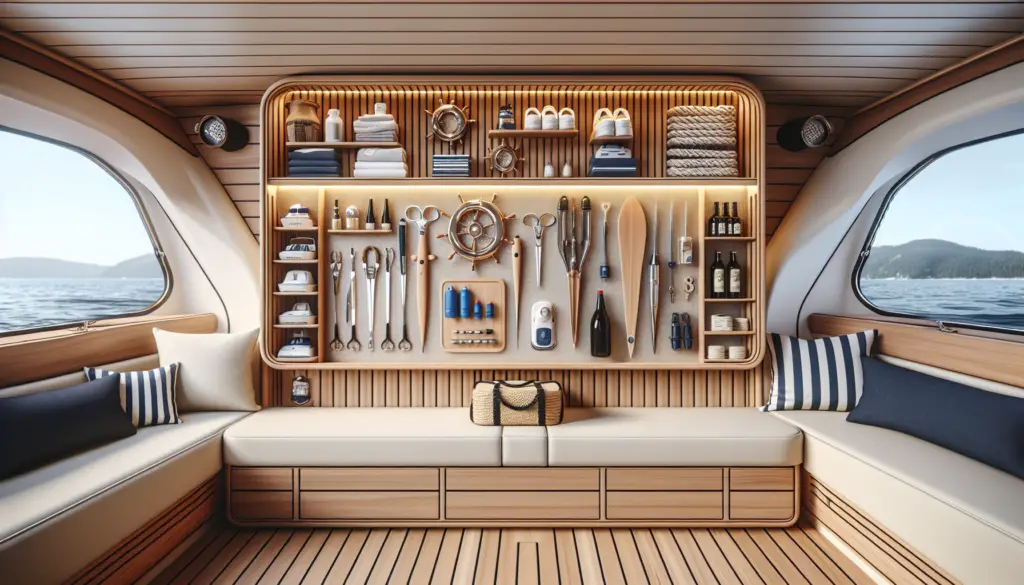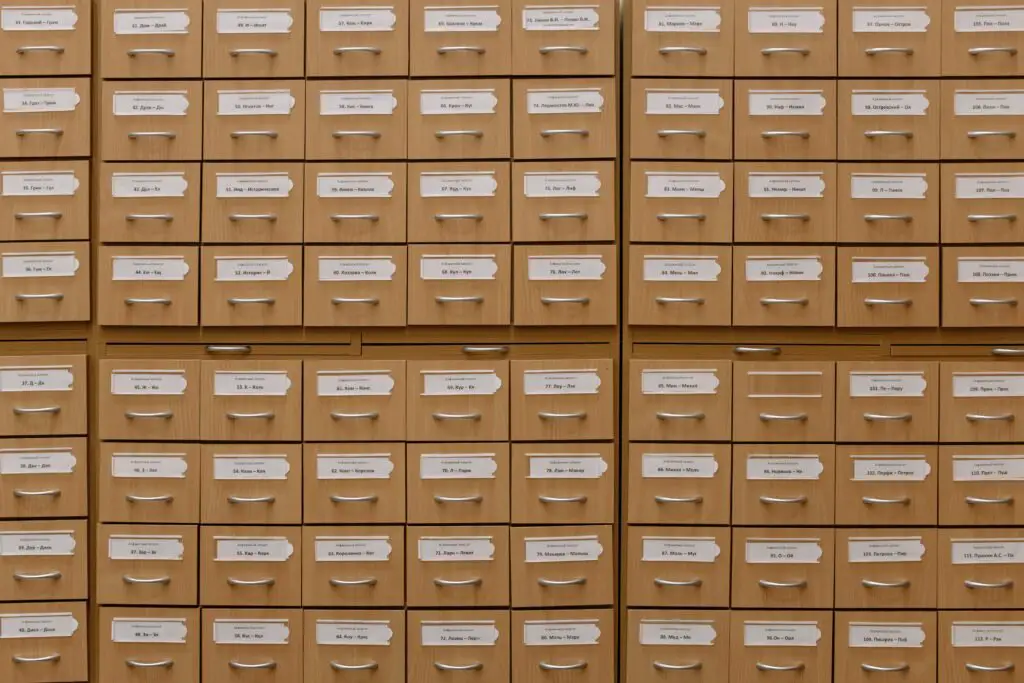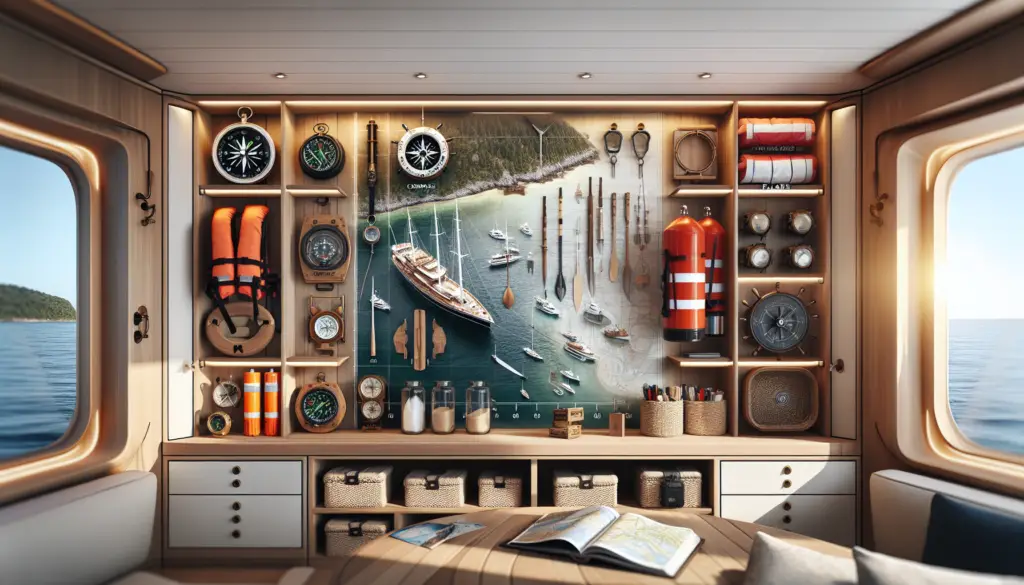Imagine cruising along the open water, feeling the warm breeze on your face and the exhilaration of freedom. As you navigate through the waves, you can’t help but notice the clutter and lack of storage space on your boat. Fear not, because we have the solution that will not only enhance your boating experience but also make your life easier. In this article, we will guide you on how to add custom shelving and storage to your boat, ensuring that everything has its rightful place and maximizing the space available. Get ready to embark on your next adventure with a perfectly organized and functional boat.

Planning and Measurements
Assessing your storage needs
Before you start adding custom shelving and storage to your boat, it’s important to assess your storage needs. Take a look at the items you typically bring on your boat trips, such as fishing gear, life jackets, or snacks, and determine how much storage space you require. Consider the size and weight of the items as well, as this will affect the type and size of the shelving and storage units you choose.
Taking precise measurements
Once you have determined your storage needs, it’s time to take precise measurements of the available space in your boat. Take into account any obstacles or existing features that you need to work around, such as seating or control panels. Measure the length, width, and height of the areas where you plan to install shelving units. This will ensure that your custom shelving fits perfectly and maximizes the available space.
Considering weight capacity
Another important factor to consider when adding custom shelving and storage to your boat is weight capacity. Remember that your boat will be moving and bouncing in the water, so you need to ensure that the shelving and storage units can safely hold the weight of the items you plan to store. Check the weight capacity of the materials you choose and calculate the total weight of the items you will be storing to ensure that it does not exceed the limits.
Choosing the Right Materials
Marine-grade plywood
When it comes to materials for custom boat shelving and storage, marine-grade plywood is a popular choice. It is specifically designed to withstand the harsh marine environment, as it is resistant to moisture, rot, and insects. Marine-grade plywood is durable and lightweight, making it ideal for boat storage solutions. It can be easily cut and shaped to fit your specific needs, and it can be painted or finished to match the interior of your boat.
Fiberglass
Fiberglass is another excellent choice for custom boat shelving and storage. It is lightweight, strong, and resistant to water and corrosion. Fiberglass can be molded into various shapes and sizes, allowing for customized storage solutions. It is also easy to clean and maintain, making it a practical option for boating enthusiasts. Keep in mind that fiberglass may require professional installation, so it’s best to consult with experts if you choose this material for your boat storage.
Acrylic
Acrylic, also known as Plexiglas or Lucite, is a versatile material that can be used for boat shelving and storage. It is transparent and lightweight, making it perfect for creating shelves that allow you to easily see and access your items. Acrylic is also resistant to moisture and UV rays, making it suitable for the marine environment. However, it is important to note that acrylic can scratch easily, so you may need to take extra precautions to protect the surface.
Building Custom Shelving
Creating a design plan
Before you start building custom shelving for your boat, it’s essential to create a design plan. Consider the available space, your storage needs, and the materials you have chosen. Sketch out the design, including the dimensions and any additional features you want to incorporate, such as dividers or compartments. This will help guide you during the construction process and ensure that your custom shelving meets your specific requirements.
Cutting plywood to size
If you have chosen marine-grade plywood for your custom shelving, you will need to cut it to the appropriate size. Use the measurements you took earlier to mark the plywood accurately. Use a circular saw or a jigsaw with a fine-tooth blade to cut the plywood along the marked lines. Take your time and make precise cuts to ensure that the shelves fit snugly in the designated areas.
Assembling the shelves
Once you have cut the plywood to size, it’s time to assemble the shelves. Depending on your design plan, you may need to attach additional pieces, such as dividers or supports, to create the desired storage configuration. Use marine-grade screws or adhesive designed for boat use to secure the pieces together. Double-check that everything is level and secure before proceeding to the installation step.
Installing the Shelving Units
Determining the ideal location
Before installing the custom shelving units, carefully consider the ideal location for each unit. Think about accessibility, stability, and weight distribution. You want the shelves to be easily reachable while ensuring that they do not obstruct your movement or interfere with existing fixtures. Take into account any potential hazards, such as sharp edges or protrusions, and make necessary adjustments to ensure safety.
Securing the shelving units
To ensure that the shelving units stay in place while your boat is in motion, it is crucial to secure them properly. Use stainless-steel brackets or marine-grade screws to attach the shelving units to the boat’s structure. Make sure to anchor the shelves securely, taking into account the weight they will be carrying. If needed, reinforce the installation points with additional support brackets or adhesive.
Using marine-grade adhesive
In addition to securing the shelving units with brackets or screws, it is recommended to use marine-grade adhesive to provide additional stability and prevent movement. Apply the adhesive to the contact points between the shelving units and the boat’s structure, following the manufacturer’s instructions. This will create a strong bond that can withstand the vibrations and movements experienced during boat trips.

Utilizing Vertical Storage
Installing overhead shelving
Make the most of the vertical space in your boat by installing overhead shelving units. These shelves can be mounted on the ceiling or under existing structures, such as T-tops or arches. Overhead shelves are perfect for storing items you don’t need immediate access to, such as spare life jackets or safety equipment. Ensure that the overhead shelves are securely attached and do not obstruct any important features or obstruct your line of sight.
Harnessing wall space
Another way to optimize storage in your boat is by utilizing the wall space. Install wall-mounted shelves or cabinets to keep frequently used items within easy reach. Consider adding hooks, racks, or organizers to maximize the available space. Wall-mounted storage solutions are great for storing personal belongings, fishing gear, or small supplies. Just be mindful of weight distribution and ensure that the added storage does not compromise the stability of your boat.
Adding hanging storage solutions
If you need additional storage for items like fishing rods or wet towels, consider adding hanging storage solutions. Install rod holders or hooks on the boat’s structure to safely hang and secure your fishing gear. Hang storage baskets or nets on walls or beneath seats to store smaller items that tend to clutter the boat. Hanging storage solutions are not only practical but also help keep your boat tidy and organized.
Optimizing Floor Space
Designing under-seat storage
Make the most out of the available floor space by designing under-seat storage compartments. Determine the dimensions and accessibility of the compartments based on the seats in your boat. These storage compartments can be used to store larger items, such as coolers or water sports equipment. Consider adding hinged lids or access panels for easy retrieval of the stored items. Make sure the compartments are securely fastened to prevent any movement or accidents while underway.
Creating custom floor compartments
In addition to under-seat storage, you can create custom floor compartments to maximize your boat’s storage capacity. These compartments can be used to store items that need to be easily accessible, such as snacks or personal belongings. Measure the available space and design the compartments accordingly. Use marine-grade hinges and latches to secure the lids and prevent them from opening accidentally. Ensure that the compartments are watertight and adequately sealed to protect the stored items from water damage.
Installing pull-out drawers
If you prefer a more organized and convenient way to store items in your boat, consider installing pull-out drawers. These drawers can be mounted beneath seats or within cabinets, providing easy access to the stored items. Measure the available space and design the drawers to fit perfectly in the designated areas. Use marine-grade drawer slides to ensure smooth and reliable operation. Pull-out drawers are especially useful for storing smaller items or items that you frequently need during your boat trips.

Securing Items in Rough Waters
Using bungee cords and cargo nets
In rough waters, it’s essential to secure your stored items to prevent them from shifting or falling. Use bungee cords or cargo nets to hold down larger items, such as coolers or tackle boxes. Attach the cords or nets to secure points on the boat and ensure a tight and stable hold. Regularly check the tension and condition of the cords or nets to maintain their effectiveness.
Installing non-skid mats
To prevent items from sliding or shifting while underway, install non-skid mats on the shelving units or inside storage compartments. These mats provide a textured surface that helps grip the stored items and reduce movement. Choose mats specifically designed for marine use, as they are resistant to water, sunlight, and other environmental factors. Ensure that the mats fit the dimensions of the shelves or compartments and are properly adhered to prevent any accidents.
Creating custom brackets
For added security, consider creating custom brackets to secure specific items in place. Measure the dimensions of the items and design brackets that will hold them securely to the shelves or compartments. Use marine-grade materials and hardware to ensure durability and resistance to the marine environment. By creating custom brackets, you can tailor the storage solutions to fit your specific items and prevent any shifting or damage during rough waters.
Adding Convenient Accessories
Installing cup holders
No boat is complete without cup holders for your beverages. Install cup holders in convenient locations, such as near seating areas or on the console. There are various types of cup holders available, including built-in options or clamp-on holders that can be easily attached and removed. Choose cup holders that are specifically designed for marine use to ensure they can withstand exposure to water and prevent spills.
Mounting fishing rod holders
For fishing enthusiasts, mounting fishing rod holders is a must. These holders keep your fishing rods secure and accessible while freeing up your hands for other tasks. Choose rod holders that can be mounted on the boat’s structure, such as gunwales or bulkheads. Ensure that the holders are securely attached and can withstand the stress and movement associated with fishing in rough waters. Having fishing rod holders on your boat will enhance your fishing experience and keep your rods organized and protected.
Adding hooks and clips
Hooks and clips are versatile accessories that can be used to hang various items, such as towels, hats, or life jackets. Install hooks or clips on walls, rails, or other suitable locations to create additional storage options. Choose hooks and clips made of corrosion-resistant materials to withstand the marine environment. Ensure that the hooks or clips are securely fastened and can support the weight of the items you plan to hang.

Enhancing Organization with Containers
Selecting proper storage containers
When it comes to organizing your boat, selecting the proper storage containers is crucial. Look for containers that are durable, water-resistant, and easy to clean. Plastic or waterproof fabric containers are popular choices for marine storage. Consider the size and shape of the items you plan to store and choose containers that can accommodate them. Opt for containers with secure lids or closures to prevent water damage or spills.
Utilizing clear bins and dividers
Clear bins and dividers are excellent tools for organizing your boat storage. Transparent bins allow you to easily see the contents without having to open them. This makes locating and retrieving items much more efficient. Use dividers within the bins to further separate and categorize smaller items. Label the bins or use color-coded dividers to create a more systematic organization system. Clear bins and dividers will not only keep your boat tidy but also make it easier to find what you need quickly.
Incorporating stackable options
To make the most of limited storage space, incorporate stackable storage options. Stackable containers or storage bins allow you to vertically maximize the available space in your boat. Opt for containers with secure interlocking features to ensure stability and prevent them from shifting during boat trips. Stackable storage options are particularly useful for storing smaller items or maintaining a neat and organized storage area.
Maximizing Hidden Storage Spaces
Utilizing unused nooks and crannies
In your quest for additional storage, don’t overlook the unused nooks and crannies of your boat. Inspect the corners, under seats, or behind panels for hidden storage opportunities. These areas can often be utilized to store smaller items or personal belongings. Consider adding custom storage compartments or shelves in these spaces to maximize the available storage capacity of your boat.
Creating secret compartments
For added security or to keep valuable items out of sight, consider creating secret compartments in your boat. These compartments can be concealed within existing structures or cleverly designed to blend in with the boat’s interior. Install hidden latches or access points to ensure that only you know their location. Secret compartments are ideal for storing items like electronics, wallets, or passports that you want to keep safe while enjoying your boating adventures.
Building hidden storage compartments
If you have the skills and resources, building hidden storage compartments can offer unique and custom storage solutions. These compartments can be incorporated into the boat’s structure or disguised as other functional features, such as seating or flooring. Consult with professionals or experienced boat builders to ensure that the hidden compartments are properly designed, safe, and align with the structural integrity of your boat.
By following these steps and incorporating custom shelving and storage solutions, you can optimize the storage capacity of your boat while keeping everything organized and secure. Remember to assess your storage needs, measure the available space, and choose appropriate materials. Building and installing custom shelving units, utilizing vertical and floor spaces, securing items in rough waters, and adding convenient accessories will enhance your boating experience and make every trip more enjoyable. So, get started and take your boat storage to the next level!


